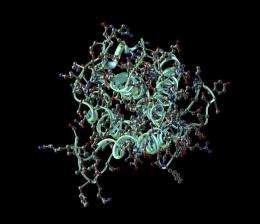Scientists improve biomarker detection technique

Scientists from NPL's Biotechnology group have developed a new strategy to enable quicker and more precise detection of biomarkers - proteins which indicate disease. The work marks a new research direction for the group, and they hope the technique is an early step towards tools to detect Alzheimer’s and cancer at the molecular level.
Any disease has proteins or levels of proteins that are specifically linked to it - biomarkers. Identifying these in body fluid such as blood can be a powerful medical tool, so the search for new diagnostic and prognostic biomarkers to underpin targeted medicines is of growing priority.
However, the potential of biomarkers is currently hampered by technical difficulties in detecting them. They are often present at very low levels, in amongst many other different proteins. Reducing a sample down to a concentration where they could be identified is difficult and time-consuming.
"This new strategy uses a probe to 'fish' for likely proteins, selecting them from a crowded blood sample," says Dr Max Ryadnov, Principal Research Scientist in the group, who co-authored the paper. "A microgel probe works like a sponge, picking up proteins which have a charge or mass within a certain range."
Mass spectrometry - an analysis where the molecules are charged and identified from their mass-to-charge ratio - can then be used to see whether or not the biomarker is present in this more select sample.
The team tested the probe on fluids containing human growth hormone - a protein which is used therapeutically and is also banned in competitive sports. It is typically found in blood at very low levels, at around 100 nanograms per millilitre. However, the probe was able to pick up the hormone even when only 40 nanograms per millilitre were present.
Another problem with current biomarker detection is speed. This new strategy could greatly cut the time needed to search for a biomarker in a fluid. "You can do it in a day instead of a few days or even a week," says Dr Ryadnov.
The Biotechnology group want to develop biomarker detection techniques further, and are already working on a probe which can select not only one specific protein, but also a specific shape of the target protein, rather than ranges of size or charge. They also want to see tests that can quantify levels of a protein, rather than just detecting if it is present or not.
"What we're trying to do is simplify testing," said Paulina Rakowska, Higher Research Scientist in the group. "These types of probe would, in theory, be suitable for different classes of diseases, mainly Alzheimer's and the like, but I also hope they would have applications for cancer."
More information: The paper 'MiS-MALDI: microgel-selected detection of protein biomarkers by MALDI-ToF mass spectrometry' was published in the Royal Society of Chemistry journal, Molecular BioSystems.
Provided by National Physical Laboratory
















